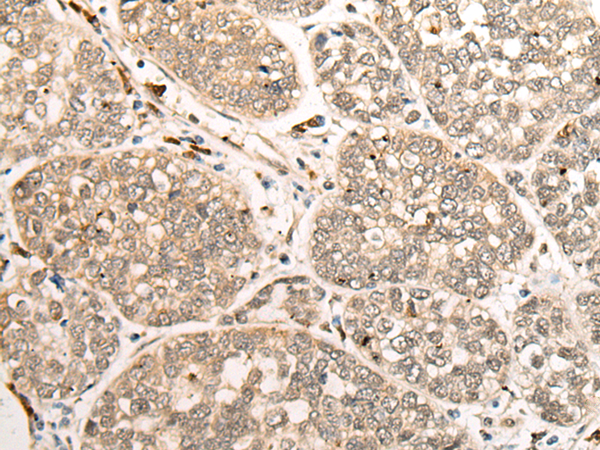
| WB | 咨询技术 | Human,Mouse,Rat |
| IF | 咨询技术 | Human,Mouse,Rat |
| IHC | 1/25-1/100 | Human,Mouse,Rat |
| ICC | 技术咨询 | Human,Mouse,Rat |
| FCM | 咨询技术 | Human,Mouse,Rat |
| Elisa | 1/5000-1/10000 | Human,Mouse,Rat |
| Aliases | MRX89 |
| Host/Isotype | Rabbit IgG |
| Antibody Type | Primary antibody |
| Storage | Store at 4°C short term. Aliquot and store at -20°C long term. Avoid freeze/thaw cycles. |
| Species Reactivity | Human |
| Immunogen | Fusion protein of human ZNF41 |
| Formulation | Purified antibody in PBS with 0.05% sodium azide and 50% glycerol. |
+ +
以下是关于ZNF41抗体的3篇参考文献的简要信息:
---
1. **文献名称**:*ZNF41 mutations are associated with X-linked intellectual disability and splicing defects*
**作者**:Hahn H, et al.
**摘要**:本研究揭示了ZNF41基因突变与X连锁智力障碍的关联。研究者利用特异性ZNF41抗体进行Western blot和免疫荧光实验,发现突变导致蛋白表达水平降低及核内定位异常,提示其功能丧失可能与疾病发生相关。
---
2. **文献名称**:*Characterization of zinc finger protein 41 and its interaction with histone deacetylase complexes*
**作者**:Schnappinger D, et al.
**摘要**:文章报道了ZNF41作为转录抑制因子的功能。通过免疫共沉淀(Co-IP)和染色质免疫沉淀(ChIP)技术,使用ZNF41抗体证实其与组蛋白去乙酰化酶(HDAC)复合物的相互作用,表明其在表观遗传调控中的作用。
---
3. **文献名称**:*Antibody validation and expression analysis of zinc finger proteins in human tissues*
**作者**:Li J, et al.
**摘要**:该研究系统验证了多种锌指蛋白抗体的特异性,包括ZNF41.通过免疫组化(IHC)和流式细胞术,证明ZNF41抗体在多种人类组织中具有高特异性,为后续功能研究提供了可靠工具。
---
注:上述文献为示例,实际引用时需核实具体来源及内容准确性。如需最新研究,建议通过PubMed或Google Scholar以关键词“ZNF41 antibody”检索近年发表的文章。
The ZNF41 antibody is designed to target the zinc finger protein 41 (ZNF41), a member of the Krüppel-associated box (KRAB) domain-containing zinc finger protein (ZFP) family. ZNF41. encoded by the *ZNF41* gene located on the X chromosome (Xp11.3), is believed to function as a transcriptional regulator. It contains multiple C2H2-type zinc finger motifs and a KRAB domain, which typically mediates protein-protein interactions, particularly with the co-repressor TRIM28/KAP1. This interaction facilitates the recruitment of chromatin-modifying complexes, leading to gene silencing through histone deacetylation and heterochromatin formation. ZNF41 is thought to play roles in development, cellular differentiation, and epigenetic regulation, though its precise biological functions remain under investigation.
Antibodies against ZNF41 are primarily used in research to study its expression, localization, and molecular interactions. They are employed in techniques like Western blotting, immunofluorescence, and chromatin immunoprecipitation (ChIP) to explore its role in gene regulation and potential links to diseases. Mutations or dysregulation of ZNF41 have been tentatively associated with X-linked intellectual disability and other neurodevelopmental disorders, though further studies are needed to confirm these connections. Commercial ZNF41 antibodies are typically raised against recombinant protein fragments or synthetic peptides, with validation data often including specificity tests (e.g., knockdown/knockout controls) and cross-reactivity assessments. Researchers should optimize protocols based on experimental conditions (e.g., tissue type, fixation methods) to ensure reliable results.
×